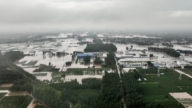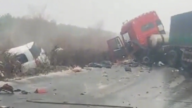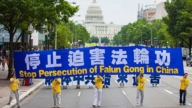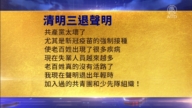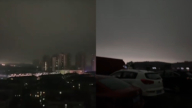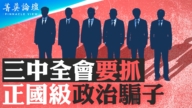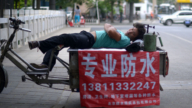【新唐人2011年6月3日讯】在内蒙古早前发生的大规模蒙族人的抗议,中共采取了严厉的压制措施。到6月2号,当局继续加强安全戒备和消息的封锁。在呼和浩特市的民众向本台反映,呼和浩特气氛仍然紧张,处处设卡,政府机关不准靠近,部分高校不准师生自由出入。
呼和浩特市的蒙古族人,在网上发起有近千人参加的5.30集会,因当局的大力镇压而告终。紧跟着的两天,气氛依旧紧张。6月2号到呼和浩特市上访的访民,向记者描述了呼和浩特市的情况。
访民:“我现在就在现场,在呼和浩特,出入不自由。那都是军队和警察,都戒严了,出入都得检查,学校出入都检查,内蒙大学、内蒙师范大学、内蒙农业大学,任何人都不能靠近这几个地方。挂着警戒线,出入都得检查。”
香港《无线电视台》周二从呼和浩特发回的报导说,当地大学封校要到6号才解封,也就是要等到敏感日“六四”之后。
这位访民还透露,他去政府机关上访都不接待,打电话也没人接。
访民:“政府门都戒着严,任何人不能靠近内蒙古党委政府,我今天就刚从那来。我在呼市上访呢,现在那里党委还不接见,戒严呢,都是武警和公安把着大门口,任何人不能靠近。”
而中共除了在当地采取严密的安全措施之外,还加强了有关内蒙古抗议事件的消息封锁。
《美国之音》说,在世界各国媒体关注内蒙的紧张局势的同时,中国时间5月31号晚上,通过“新浪网”搜索有关内蒙古的新闻,第一条新闻是:天气新闻;而且第二、第三、第四条也都是天气新闻。
《法国国际广播电台》报导,总部设在巴黎的“无国界记者”团体周二发表公报,谴责中共政府因为内蒙古近日发生的抗议示威活动,而加紧网路封锁。
公报指出,在通辽市,一些博客作者和网民受到公安传讯,在呼和浩特,许多网吧由于连网速度不够而关闭,移动电话网路也完全被封锁,网路聊天工具QQ和其他社交网路都被切断。微博、新浪等迷你博客里,有关游行活动的内容全部被删除。
内蒙古过去一个月来接连发生的示威事件,导火索是一名汉族司机轧死了一名牧民,以及当地一名抗议者,参加了反对当地煤矿造成污染的示威活动,而被打死的事件。
追溯历史,中共建政以来,有成千上万的蒙古人遭到当局的杀戮。资深政治评论家曹长青在1997年曾与蒙古族学者巴赫进行访谈。
巴赫在访谈中谈到,内蒙古也像新疆一样,在20世纪初就开始了独立运动。当时的国民政府允许蒙古人高度自治,允许保留蒙古自卫军十个师。国民政府负责外交和国防,其他都交由蒙古自治政府自理。
巴赫介绍说, 1950年,中共军队进军内蒙古,在内蒙实行了所谓的“社会主义改造”:开矿建厂,建造重工业,并强迫蒙古牧民在草原上种粮食,强行推行“人民公社”政策,同时把大量汉人迁入内蒙。
在文革中,北京军区副司令腾海清调到内蒙出任“内蒙古自治区革委会”主任。他在清查所谓的“内人党”——内蒙古人民党时,逮捕关押了80万人。在这场大杀戮中,有5万蒙古人被拷打迫害致死,多达50万人致残。
袁红冰(中国法学家):“那么,这一次的运动,不由得让我想到,2008年的时候,在西藏,在拉萨,年轻的藏人啊,迎着共产党的枪口,走过去,他高声喊道,我就是几十年前被你们杀死的藏人。今天这个现象,可以说在内蒙古又重现了。也就是说,几十年前,被共产党屠杀,因为共产党屠杀死去的那些,有良知的蒙古族知识份子,现在,又在青年一代的生命中复活了。”
袁红冰认为,中共对内蒙古人实行的文化性的种族灭绝政策,终究会失败的。蒙古人为了自己的尊严和生存,一定会起来反抗中共暴政。
新唐人记者梁欣、李静、肖颜采访报导。
Inner Mongolia Still Under Martial Law
The Chinese Communist Party (CCP) adopted
a harsh repressive measure to the recent large-scale
protest in Inner Mongolia. On June 2, authorities
continue to tighten security and block information.
People in Hohhot told NTD that the atmosphere
in Hohhot remained tense. No one can approach
government agencies, students and staff at some
universities aren’t allowed to enter or leave school.
Originally initiated online, Inner Mongolians
in Hohhot held an assembly with nearly 1,000
participants on May 30. The atmosphere remains
tense until this point. Petitioners who went
to Hohhot told NTD reporter of the situation there.
Petitioner: “I’m here in Hohhot. We don’t have
freedom to come and go. Military and police forces
are everywhere. Martial law is imposed. People
need to check in and out at schools, Inner Mongolia
University, Inner Mongolia Normal University,
Inner Mongolia Agricultural University.
No one is allowed to get close to these places.
They all have to be checked.”
Hong Kong’ TVBPV reported back from Hohhot
on Tuesday that local universities will reopen
on June 6, after the sensitive June 4.
The petitioner also said that no one at government
agencies met him, nor would they answer his calls.
Petitioner: “Martial law is enforced. No one can
get close to the CCP committee compound. I came
to Hohhot to petition, but the CCP committee
members did not meet me. The gate was guarded
by armed police and the public security staff.
No one is allowed to get close.”
In addition to the security measures,
the CCP also strengthened its news blockade.
On May 31, Voice of America reported that even
with worldwide attention on the tense situation
in Inner Mongolia, when one searches Sina.com ,
the first news article is about the weather,
along with the second, third and fourth.
According to Radio France Internationale,
Paris-based Reporters Without Borders (RWB)
issued a statement on Tuesday condemning CCP’s
Internet blockage on protests in Inner Mongolia.
RWB stated that in Liaotong City netizens
were summoned by the public security bureau.
In Hohhot, many Internet cafes closed
due to insufficient network speed. Mobile phone
networks are also completely blocked. QQ online
chat and other social networking tools are cut off,
and blogs about the protest were all deleted.
The protests in Inner Mongolia over the past month
were originally caused by two incidents: a Chinese
driver run over and killed a herdsman, and a local
protester beaten to death for taking part in rallies
against the pollution by the local coal mines.
Since CCP established its regime, tens of thousands
of Mongolians have been killed. Cao Changqing,
a senior political commentator interviewed
Mongolian scholar Bache back in 1997.
Bache: “Like Xinjiang, Inner Mongolia started
its independence movement in the 20th century.
The then KMT government gave Mongolians
a high degree of autonomy, allowing them to keep
10 divisions of self-Defense army. The KMT
government is responsible for foreign affairs
and defense, everything else was taken care of
by the autonomous government of Mongolia.”
Bache said that in 1950, the CCP army entered
Inner Mongolia and implement the so-called
“socialist transformation”, such as building mining
plants and heavy industries. CCP forced Mongolian
herders to plant grains, and implemented
the “people’s communes” policy. Meanwhile,
large numbers of Han people moved into the region.
During the Cultural Revolution, Beijing Military
Region Deputy Commander Teng Haiqing
was Transferred to Inner Mongolia to be the
“Revolutionary Committee Chair of the
Inner Mongolia Autonomous Region”. He arrested
over 80,000 people during the “clean-up”
of the Mongolia People’s Party. 50,000 Mongols
were tortured to death, and as many as
500,000 people were left disabled.
Yuan Hongbing (Chinese jurist): “This reminds me
of Lhasa, Tibet in 2008, when Tibetan youth walked
to the guns and shouted: ‘I am the Tibetan you killed
decades ago.’ Today, its the same in Inner Mongolia.
The Mongolian intellectuals massacred by the CCP
decades ago speak through the young generation.”
Yuan Hongbing thinks the CCP’s cultural genocide
in Inner Mongolia will eventually fail.
Mongols, for their own dignity and survival,
will stand up to protest against the CCP tyranny.
NTD reporters Liang Xin, Li Jing and Xiao Yan



